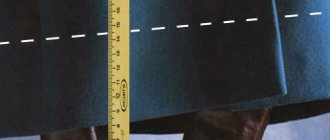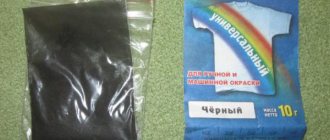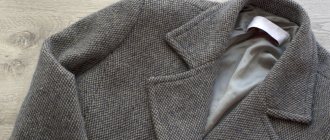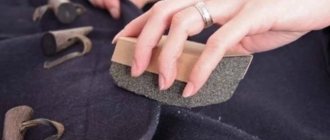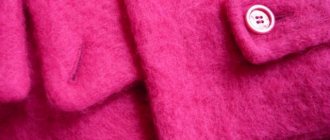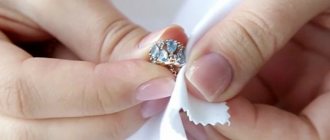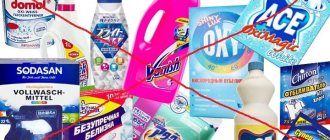People who prefer different styles have coats and drapes in their wardrobes. This product helps you feel stylish and confident. If a demi-season drape product is sewn in a classic style, it will remain relevant for years. But how to preserve its original appearance for many years? Let's talk in particular about how to wash a drape coat at home.
A drape coat can be removed from street dirt by dry or wet cleaning. If, during inspection, intense contamination was found, you will have to clean the product at home using water and cleaning products.
A rare drape product can be washed in an automatic washing machine. Such cleaning is allowed only if the information on the label does not strictly prohibit it.
Cleaning a drape coat without cleaning products
Dry cleaning at home allows you to rid your drape coat of city dirt and small debris.
- Use a clothes brush in the direction of the pile, hanging the item on a hanger.
- If necessary, additionally go over the fabric with a cake of bread crumbs or wood shavings.
Decide how often to clean this demi-season item of clothing at home, taking into account the frequency of wear and the cleanliness of the city in which you live. In some situations, the desire to clean your coat at home will arise every day, in others - once a week or even less often.
If the contamination is more serious, do not immediately try to wash the product at home by hand, much less in a washing machine. If there are no deep-seated stains, try cleaning it first with a dry and then a damp clothes brush. If this is not enough to clean your drape coat at home, resort to using chemicals.
How much does it cost to dry clean a coat?
Prices for dry cleaning coats
| Name | Unit change | Price, rub.) |
| Short coat / Demi-season coat, winter, insulated raincoat | PC. | 1580 rub. |
| Raincoat, summer coat, poncho | PC. | 1300 rub. |
| Faux/real fur insulated jacket | PC. | 1290 / 2650 rub. |
| Jacket with suede, leather, fur trim. | PC. | 2280 rub. |
Deep cleaning with carpet powder
A light coat can be washed at home with dry powder, which is used for cleaning carpets, without placing it in a washing machine, and even without water. In this case, dirt removal occurs in three stages:
- Lay the coat out on a horizontal surface and sprinkle with carpet powder.
- We wait about half an hour.
- We clean off the powder with a dry clothes brush.
If your coat is black or another dark color, then dry cleaning with powder at home is not for you.
In this case, you can only clean the product at home using a wet method, the steps of which are described below.
- Dissolve carpet cleaning powder in water according to instructions.
- Apply foam evenly to the surface of the fabric.
- After complete drying, clean the product with a brush.
This way you can wash your favorite coat without crumpling it in the washing machine. This cleaning at home will refresh it to the condition it was in when you bought it.
Wet method
Using a slightly dampened sponge or brush, you can clean the coat from small stains, dust and dirt. To do this, use a well-wrung out sponge to go over the entire surface of the coat, removing any adhering dirt.
Important! After treatment with wet materials, the coat should be thoroughly dried with natural ventilation. You should not use a hairdryer, fan or heating appliances for this; this can lead to a complete loss of the product’s qualities and appearance.
To remove more serious stains, you can use a carpet cleaner or conditioner.
The first substance is foamed and applied to the surface of the product so that the fabric does not get wet. After some time, the dirty foam is cleaned off with a brush and the fabric is wiped with a damp sponge. You can also use a small amount of fabric softener diluted in clean water. A soft sponge is moistened in this solution and passed over the entire surface of the product. Then the composition should be washed off with a damp, clean cloth and the drape coat should be allowed to dry.
Getting rid of stubborn stains
If, when examining the product, you notice stains that cannot be removed at home (stains from blood, ink, cosmetics, food coloring), take it to the dry cleaner. For less serious stains, try cleaning it yourself. Do not rush to spin the coat in the automatic machine, as there is a risk that it will lose its shape. It is better to follow one of the following tips for removing stains of various types at home.
- Remove grease stains with purified gasoline. Apply a cloth soaked in it on the back side, and a dry napkin on the front side.
- A fresh grease stain can be removed by applying a dry paper towel and running a warm iron over it.
- You can clean your coat from tea or coffee stains with a mixture of ammonia and glycerin (1/2).
- Hydrogen peroxide can help remove beer stains.
- Try removing difficult stains with a solution made from half a glass of cool water and a teaspoon of ammonia and detergent.
- Treat the greasy area of the collar with a cotton swab with a mixture of salt and ammonia (4/1).
- Treat the shiny area with either a mixture of vinegar and alcohol (1/1), or tea leaves (if the coat is dark). Sometimes steam treatment of the problem area helps.
- Special-purpose products will help you clean a drape coat.
How to get rid of shine on a down jacket?
Mix one glass of peroxide with two glasses of water and add 6 drops of ammonia to the liquid. Treat problem areas with a sponge, and then rinse the product well with water.
Interesting materials:
When are fruit tree seedlings planted in the spring? When to plant grape cuttings in spring? When to plant chrysanthemums in spring? When to plant raspberries in spring? When to plant fruit trees in spring? When to apply ammonium nitrate in spring? When to apply nitrogen fertilizers in spring? When to apply fertilizer in spring? When to fertilize your lawn in the spring? When to fertilize fruit trees in spring?
How to wash a coat by hand
Can a drape coat be washed by hand or in a washing machine? Almost every label on such a product states that this cannot be done. If yours doesn’t have such instructions, you can wash it. But this must be done carefully and infrequently, otherwise it will become deformed and the fabric will look worn out. It is preferable to wash a drape coat not in a washing machine, but by hand. How to do this correctly?
- Soak the product in cool water for 10 minutes. It is advisable not to crumple it.
- Wash with gentle movements, leaving the coat flat. Use only liquid laundry detergent or baby shampoo, otherwise you may not be able to wash the product successfully.
- When rinsing, do not spare water, especially if the item of clothing is dark in color, otherwise soap stains may be noticeable.
- Never try to squeeze water out of the product yourself. Hang it on a hanger and wait for the water to drain.
- Iron the coat while it is still damp. Turn on the steam function of the iron and iron only through gauze or thin cotton cloth.
- Hang the coat on hangers again until completely dry.
How to dry?
The process of drying a drape coat is a very difficult and troublesome task, which takes place in several stages:
- A wet product weighs quite a lot, so you need to make sure that the fastening is secure, on which the item will be initially dried and excess moisture will drain off.
- Then the coat should be switched to horizontal drying mode, wrapping it in a fabric that absorbs moisture well (for example, a terry towel).
These towels will need to be changed several times as they fill with water (this will speed up the drying process). - You can continue to dry the product either horizontally or vertically by hanging it in a well-ventilated place.
- The coat does not require ironing if it has been well straightened before drying. Otherwise, you should steam it through a damp gauze cloth, or using a steam generator.
The product must dry on its own; it is not recommended to use various electrical appliances designed for drying, or hanging the coat on a radiator.
Rules for washing drape products in a washing machine
At home in the washing machine, clean your coat from dirt only in the most extreme cases, even if the manufacturer does not prohibit it. Follow these rules:
- Choose a delicate mode without spinning and a water temperature no higher than 30°C.
- Before washing, remove fur and all decorative parts (especially metal ones).
- Use only gel detergent.
- After finishing the washing cycle in the washing machine, straighten and carefully hang the coat on a hanger. Do not twist it under any circumstances.
- Iron the damp item through gauze or cloth.
- Hang on hangers until completely dry.
A drape coat looks elegant and stylish only if it does not bear the visible imprint of time. A careful attitude will help keep it in its original form longer. If you can avoid washing, avoid. Dry and wet cleaning will not ruin your favorite item.
Why does he get dirty?
The collar is constantly in contact with the skin of the neck, which is equipped with sweat and sebaceous glands. These glands are exogenous, i.e. secrete out. You have noticed this more than once: during heavy physical activity, or during excitement, the neck sweats first. Accordingly, the collar of the garment becomes contaminated. The coat will instantly lose its appearance if the collar is dirty or greasy.
The second problem with the collar is stains from powder and foundation. If a woman constantly uses foundation, pinkish spots often adorn the collar of her drape coat. Some fashionistas adapt to protect their collar with a scarf.
After all, after washing, the scarf will quickly acquire its original appearance. But a collar made of drape is unlikely.
Lifehack 10 Daily coat care
We hope that the above methods for cleaning a coat will help in the fight against stains, however, we note that simple methods of everyday coat care will help you avoid complex long-term procedures. 1. Before doing anything to the coat, carefully study the labels on it. 2. Always hang your coat on hangers that fit properly. 3. Store your coat in a special case, which will help keep it fresh. 4. When storing a coat, it is better to fasten it with all the buttons, and also remove the contents of the pockets - this way you can avoid distortions. 5. Clean stains as soon as they appear, as they will be much more difficult to remove after some time. 6. Dry the coat after wearing it in conditions of high humidity, avoiding direct sunlight. 7. Wipe your coat every week with a special brush, sponge or roller (depending on the material of the product). 8. Once a year, take your coat to the dry cleaner - no matter how carefully you wear it, the item is worth refreshing. 9. Do not apply a large amount of perfume to your coat - the fabric can not only absorb the smell, but even change color (deodorants or perfumes can discolor the coat or make bright colors dull). 10. Remove pellets from time to time - their appearance is inevitable and is caused by friction in public transport, during contact with bags, backpacks, or simply in a store with other people. A special machine or simple nail scissors will help remove lumps - it all depends on the time you have.
Let's add one last thing! Of course, it is better to entrust some products to professionals and their cleaning must be carried out with special means, special technologies and methods. But how can you determine when it is necessary to take a product for cleaning, and when you can do it yourself? Dry cleaning is recommended if: - the coat is white or light in color; — it is necessary to remove complex contaminants – stains from paint, oily solutions and others; - the coat is dirty, but the label states that any types of washing are prohibited.
Life hack 6 Leather coat
Wet cleaning!
Leather is one of those materials that will probably never go out of style. Therefore, careful handling of leather products will extend their service for many years. For minor stains, a regular damp sponge will help you; once you wipe the product, not a trace of dust will remain. If there are stains of dirt on the coat, then you should use the formula: water (half a glass) + alcohol (one tablespoon) + liquid soap (one tablespoon). Apply the resulting mixture to the stain, and then remove excess with a damp cloth or sponge.
In winter, salt marks often appear on a leather coat, so vinegar, citric acid, alcohol or glycerin will come to the rescue in the fight against them. Soak a cotton swab in any of these solutions and wipe the stains - voila, the coat looks like new again. After any cleaning, make sure that the item is completely dry, because a wet coat can stretch when worn.
Tip: a leather coat cannot be washed, but to freshen it up, you can wash individual sections of the lining without putting the entire product in water.
Types of self-processing
Types of self-processing There are two ways to clean a drape coat - dry and wet. How exactly to clean depends on the degree of contamination of the product, the time allotted for the procedure, and the availability of the necessary products.
Dry method
It involves quickly cleaning the product without moisturizing and the need to use additional time to dry the item. For this procedure you will need a hanger, a brush, rye bread, a clothes roller, rubber gloves, Vanish hand washing powder and soda. Before you start cleaning, you need to place the coat on hangers and inspect the product to determine the most contaminated areas.
At this stage, it is necessary to clean the fabric from dust, threads and hair using a clothes roller or a natural brush. Cleaning should be done in the direction of the pile.
For moderate soiling, cleaning can be done as follows:
- You need to take dry washing powder for woolen products, for example, “Laska”, and evenly sprinkle it on the coat previously laid out on the table.
- Then you need to put on gloves and lightly rub the product over the surface of the product.
- Leave the coat in this form for one hour, then remove the powder using an elastic brush or a slightly moistened sponge.
When cleaning light-colored models, including white ones, it is better to use Vanish ; it will delicately clean the surface and will not leave marks. Instead of powder, you can use soda, which can only be removed with a dry brush.
The disadvantages of this method include the impossibility of using it to clean dark-colored clothing.
Foam treatment can also be considered a dry type of cleaning. To implement it you need:
- Take any carpet cleaner, dilute it in water and lather well.
- Apply the foam to the coat, avoiding the material from getting wet, and leave until completely dry.
- Then use a brush to remove any remaining residue.
The good thing about this method is that it can be used to clean and refresh clothes quite efficiently without resorting to washing and excessive moisturizing.
Dry cleaning of drapes can be done at home using bread crumbs or sawdust. For processing, it is better to use varieties of rye bread: it rolls into balls well and adsorbs dirt. You need to crumble the bread crumb onto the coat and then start rolling it up. When using sawdust, you need to sprinkle it evenly on the laid out product, cover it with gauze and start rolling the sawdust through it with a clothes roller.
After finishing the treatment, the coat should be knocked out and cleaned with a medium-hard brush.
Wet cleaning
It is more labor-intensive and requires more time:
- For treatment, solutions of wool detergents, laundry soap, suede detergent and fabric softener are used.
- They must be dissolved in warm water and applied to the contaminated surface with a rag.
- Rub the solution into the material with light movements and then leave for half an hour.
- Then you should rinse the fabric with warm water and blot with a dry cloth.
In order to prepare a liquid product from laundry soap, you need to grind it on a coarse grater and grind it in a blender with a small amount of hot water. After obtaining a homogeneous composition and cooling the liquid to 30 degrees, you can begin cleaning.
It is recommended to use a soft natural brush.
Dark and black items can be cleaned with black tea. To do this, you need to brew loose leaf tea, moisten a sponge in it and treat the contaminated areas. After 40 minutes, rinse off the tea leaves with running water and blot with a dry cloth.
How to remove a greasy stain from a down jacket?
First of all, you should get rid of grease and oil stains. Over hundreds of years, a huge number of ways have appeared to remove such pollution without leaving any residue or consequences for the fabric. Here are some of them.
Salt, starch or flour
When you need to remove a fresh greasy stain, remember the three lifesavers: salt, starch or flour. Sprinkle any of them, sparingly, onto the desired area and leave for 15-20 minutes. The bulk substance will act as an absorbent, absorbing fat. The main thing is to try to act quickly. At the very least, the contamination will disappear; at a minimum, it will be much easier to clean later.
Another option is a mixture of salt and starch. Not only suitable for fresh dirt. Mix in equal proportions, add a little water and stir. A slurry should form, similar to sour cream.
Apply a thick layer to the contaminated area and rub gently to penetrate the fibers. After 7-10 minutes you can rinse with water
Repeat if necessary.
Vinegar + salt
Using vinegar and salt, you can also clean your down jacket from greasy stains. Dissolve 2 tbsp in 0.5 liters of water. l. vinegar 9%, add 1.5 tbsp. l. salt. Stir until the ingredients are completely dissolved. Soak a cloth in the resulting solution and start rubbing. If the stain is old, you can leave a dampened cloth on it for 15 minutes. In any case, after all the manipulations, the item must be taken out into fresh air until the next day.
Dishwashing liquid
A stain on a down jacket can also be removed with ordinary dishwashing liquid. Heat 0.5 liters of water to approximately 40 °C, add 1 tbsp. l. products and mix. Dip the sponge into the solution, but do not squeeze too hard. Blot the contaminated area with it and leave for 15-20 minutes. Then rinse off with a clean sponge. Most often this is enough to remove fat. But if the dirt is persistent, repeat the steps. This method works well on shiny areas: pocket cuffs, sleeves, collars.
Shampoo or washing gel
You can clean your down jacket at home without washing using gel or shampoo. They are usually used for different types of pollution. But if the concentrate is applied to the desired area, its effect will increase. Lay the down jacket on a horizontal surface, apply the product with a sponge to the dirt. After a third of an hour, treat the area with a wet cloth.
Features of cleaning children's outerwear
Things for babies must be treated with special care. To avoid allergic reactions, do not use gasoline or similar “odorous” substances. It is better to choose a children's stain remover or high-quality powder.
A soap solution or dishwashing detergent will also work. Dry the product well. Read the label before washing.
Thanks to our tips, you will know exactly how to care for a wool coat, how to clean difficult stains on a cashmere item, and how to refresh a neoprene item. Our tips will help you save your budget and avoid sending your favorite outerwear to the dry cleaner, where you can wait for a coat for several days or weeks.
Lifehack 8 Neoprene coat
You have to try hard to get it dirty!
Neoprene is a man-made material consisting of foam rubber sandwiched between several layers of fabric. The new technology for making coats from this material is that such things are water-repellent, bacteria do not linger or multiply in them, and any stains simply “slide off” from the products. However, there are also disadvantages to this model - the fabric does not breathe, so it is recommended to wear a neoprene coat for no more than 3 hours a day.
If you do manage to get a stain, feel free to throw the coat in the machine (using the delicate wash cycle, of course).
Advice: it is better to wash and then dry the coat twice - from the outside and from the inside.
Life hack 5 Suede coat
School eraser to the rescue!
Suede, pleasant to the touch, is one of the favorite materials of designers and fashion designers today. It is quite durable, but at the same time soft and pliable. When cleaning a suede product, you should pay attention to the fact that this material prefers dry cleaning, so when removing dust, use a regular brush, running it along the pile. A school eraser or black bread can help remove subtle stains. Among the products that help in the fight against greasy stains, starch and milk come in handy. So, you can sprinkle starch on problem areas, and then remove the excess with a brush. Grease stains can be removed with baking soda (a teaspoon in volume) diluted in milk (about 100 ml) - apply the solution, leave it for a few minutes, and then clean off the residue with a brush designed for suede.
Tip: steam will help remove creases or small folds on a suede coat - hold the product over the steam for a few minutes and it will regain its presentable appearance.
Life hack 2 Cashmere coat
Avoid squeezing and twisting!
To make this type of item, Kashmiri goat hair is used, which has a pleasant texture, softness and heat resistance. However, the price of such a product if natural fiber is used will be quite high, so analogues or substitutes are often offered in production, including wool fibers, cotton or lavsan threads, viscose textures, and so on, so cleaning results may differ slightly from expectations. Regardless of the additives to cashmere, these coats can be machine washed. To freshen your coat, use a damp cloth or gasoline diluted with hair conditioner. The same gasoline, sprinkled with talc on top, will help you easily deal with greasy stains. In the fight against unknown contaminants and traces of sweat, ammonia will be useful: in the first case, it must be mixed with glycerin and treated the stain, and in the second case, soak a cotton pad in a soapy solution and treat the stain, and then moisten it with an already known substance, then remove the remaining wet cloth.
Advice: it is better to dry the coat on a horizontal surface, since hangers can damage the shape of the product.
Cleaning suede and drape
If we are talking about a suede coat, then the collar can be cleaned with a special crepe brush. Water acidified with vinegar, in which a sponge is moistened and the suede is wiped, will also help.
To clean the collar of a drape coat you only need ammonia and water.
- Take three parts water and one part alcohol, mix and soak a cotton sponge in the solution.
- Wipe the collar in the place where grease has formed, where dirt has accumulated.
- Remove any remaining solution from the collar with a clean, damp cloth.
Alcohol washes away fat deposits well, and along with them, adhered dirt. In addition, it disinfects the fabric, killing germs. This way the collar becomes clean and fresh.
If the pollution is very strong and old, then liquid soap or shampoo comes to the rescue at home. The product is diluted in water, foamed and used to clean any type of fabric. You can wipe the collar with a soft brush, a clean cloth, a sponge or a napkin - choose what is more convenient and convenient for you.
Of course, a fluffy soft clothes brush is the most effective for cleaning, so it’s a good idea to get one to keep your wardrobe in perfect order.
Useful folk tricks
We all want to simplify our homework, and time-tested products help with this. Open the doors of cabinets and refrigerators and see what is there that will help you deal with grease on your collar.
- A dark coat made of thick fabric can be cleaned with a brush dipped in strong, freshly brewed coffee. For jacket lovers, carrying out such cleaning at any time at home will be quite simple.
- A particularly noticeable stain on the collar can be removed by wiping it with lighter fluid.
- You can moisten the collar with a spray bottle, sprinkle fine salt on it, and then clean it with a brush. Salt will absorb dirt well and take it with it, leaving us with refreshed clothes.
- A white or light coat helps tidy up hydrogen peroxide. It is slightly diluted with water and the dirt is moistened. Dirt is removed with ordinary white wool.
Instead of salt, you can use talc on a light-colored item, which also absorbs dirt particles from the fabric.
